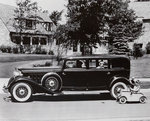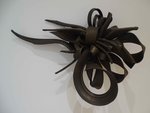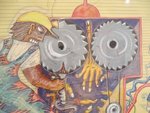




Through Aug. 8
Eli and Edythe
Broad Art Museum
Friday-Sunday Noon-6 p.m.
Free
The MSU Broad (rhymes with “Road”) Art Museum has the car packed and gassed up with a big summer exhibit, “Interstates of Mind” — a tangled web of stories, concepts and images as sprawling and far-reaching as the interstate highway system itself.
Here, the rubber doesn’t just meet the road — it pops off the wall in beautiful black blossoms made from shredded tires. The Broad is an art museum, after all.
But “Interstates” is more than art, a unique blend of historical documents, photography, painting, prints, sculpture and metallic musings on the myriad ways car culture changed Lansing, and the United States, for good or ill.
It’s also a watershed exhibit for the Broad and its new director, Monica Ramirez-Montagut.
Under Ramirez-Montagut’s leadership, the Broad is blending the kind of displays usually found in a history museum, like timelines and historic photographs, with world-class leaps of artistic inspiration, all of it grounded in local culture. The goal, she said, is to fire up all kinds of neural connections, “provide multiple points of access” to the art and bring diverse new audiences to the Broad.
Since “Interstates” opened in early spring, visitors ranging from Lansing history buffs to retired GM workers to urban planners investigating the effects of the interstate system on the design of cities — none of them specialists in art — have lingered attentively at the photographs and sculptures along with the informational displays.
“They appreciate how artists took tires and metal and made beautiful things,” Ramirez-Montagut said. “We hope it sparks curiosity, but also makes unexpected associations between ideas, materials and areas of expertise, and that’s how the creative process takes place.”
Like any epic road trip, “Interstates of Mind” starts locally and ranges for thousands of miles, combining documents and photographs from the Historical Society of Greater Lansing with major works from the Broad’s own collection and art loaned from the Flint and Detroit art institutes and Crystal Bridges Museum of American Art in Arkansas.
It’s an all-American show — even the walls are subtly painted red, white and blue — but it’s critical as well as celebratory.
In Lansing, most road trips begin on I-496, and “Interstates of Mind” is no exception. A dense band of aerial images lines the museum floor, depicting the once-vibrant Black neighborhoods on the near south side that were wiped out when the interstate cut its five-minute swath across town. The photos are dotted with stickers placed by visitors whose families or friends lived there, or who once patronized vanished businesses like Johnnie’s Record Shop and Matthew’s Restaurant.
Broad Museum senior curator Steven Bridges said the Historical Society of Greater Lansing was a “hugely important partner” in putting together this portion of the exhibit and many others.
“I can’t overstate their influence and level of support,” Bridges said.
The Broad’s Ramirez-Montagut said that from now on, most major exhibitions at the Broad will include what the staff is calling, informally, a “local corner.”
“Why is this exhibition important to Lansing or East Lansing or to Michigan?” Ramirez-Montagut said. “Are there any community leaders or stakeholders that have knowledge in this area and can we feature that? What do MSU experts say?”
“Interstates of Mind” also includes archival materials on R.E. Olds and his early auto factories, including photographs dating from as early as 1905, showing upholstery production, blacksmiths shops and body shops from the infancy of the automobile, along with Lansing street scenes and other vintage images.
The I496 floor map, like many items in the exhibit, shows that the mobility and the freedom of the auto age came at a cost, and, for many people, never came at all.
From Lansing, the exhibit whisks the viewer to distant ribbons of highway and sprawling cities forever changed by car culture, with side trips to exotic places like Futurama, the GM pavilion from the 1939 New York World’s Fair, and Henry Ford’s failed rubber plantation city of Fordlandia, deep in the Amazonian rain forest.
“It’s a choose-your-own-adventure type of experience,” Bridges said. “We designed it so you could start anywhere.”
Herding visitors along a rope line, in a regimented sequence of pre-digested lessons, is the last thing Ramirez-Montagut wants to see at the Broad.
“We are not dictating what to see first or what to see next, but allowing you to make those associations on your own,” Ramirez-Montagut said. “The creative process takes place in the minds and bodies of visitors.”
“Double Standard,” a panoramic 1961 photograph by director/actor Dennis Hopper, is a perfect starting point, a nostalgic image with a fragmented, ambivalent viewpoint. A motorist approaches a corner gas station at the convergence of three roads in southern California. The asphalt ahead of the car bristles with power lines, billboards and gas pumps; a column of cars, like bugs, crowds the driver from behind in the rear view mirror. A glimpse of hills in the distance hints at an irretrievably changed world.
“It’s an interesting comment on the work we’re trying to do — celebrating the automobile, but also we’re dealing with its complications, wrapped up with social, racial and economic history of the United States,” Bridges said.
Across from the Hopper photograph is a droll, bleak painting by one of the 20th century’s most significant artists, Philip Guston, on loan from the Detroit Institute of the Arts. (“Yes, we’ve got some heavy hitters in this one,” Bridges admitted.)
Guston’s passenger’s-eye view from a moving car, awash in pink and orange, evokes carsickness and dread more than open road excitement.
“It’s a nice conversation with the Dennis Hopper, situating us inside the car, from the back seat, having this vantage point to this vast horizon,” Bridges said. “In one sense, there’s the endless possibilities of the journey, but at the same time, that pink-red horizon is a little bit sinister as well.”
“American Roads,” a photo portfolio from the Broad’s own collection, is a showcase for road signs, advertising, roadside attractions and other aspects of the visual culture of the 1950s and 60s.
“Interstates of Mind” co-curator Georgia Erger said the portfolio captures the “excitement and banality of the open road.”
“It’s a great opportunity to show this wonderful portfolio we have, these diverse perspectives on the open road,” Erger said. “There are so many different techniques — from inside the car, aerial views, or a series of small thumbnails integrating text and image in playful ways.”
“Interstates of Mind” takes some thought-provoking turns onto little known byways of commerce and industry.
In a series of striking images by Clarissa Tossin, “When Two Places Look Alike,” the artist’s hand is seen holding cut-out photographs of houses in Belterra, a rubber plantation village in the Amazon forest, over similar houses in Alberta, a sawmill town in Michigan’s Upper Peninsula. Both places were part of the supply chain for the Model T in the United States; Belterra provided rubber and Alberta provided timber.
The houses, thousands of miles apart, are so similar you have to check the surrounding foliage (tropical or temperate?) to tell which is which. Photographs on loan from The Henry Ford in Dearborn fill out the story of the failed Fordlandia experiment.
One of the most conspicuous items in the exhibit was riveted together by El Salvadoran artist Beatriz Cortez, now based in Los Angeles — a geodesic dome fashioned from salvaged hoods, doors and trunks. It’s not just a compelling object, but a reminder of a gross material imbalance. As mountains of junk accumulate in the wake of relentless automobile production, consumption, and disposal, too many of the world’s inhabitants still face a shameful lack of the basic shelter such domes once promised.
Fossils and vines
Artists don’t have to pass safety inspections.
Rubber, chrome, glass, metal and plastic — the stuff cars are made of — break out of their assembly line roles and morph into weird and wonderful forms in the artier corners of “Interstates of Mind.”
One of the galleries surges with gleaming and twisting shapes that don’t look much like cars.
“This gallery is about form,” Erger said. “It’s about using the materials of the car as sculptural materials, but in a lot of these works, they become these very organic shapes.”
She pointed to a writhing metal sculpture by sculptor Richard Hunt. “It almost has a human or animal body form to it,” Erger mused. On a nearby partition, striking images from photographer Ralston Crawford turn crushed steel and glass from a Boulder, Colorado, junkyard into abstract forms in light, form and texture.
The act of breathing life into industrial materials has an almost primal appeal, as if humans were wrestling back their humanity from the cold artifacts of mass production. Hunt is widely acknowledged to be the foremost African-American abstract sculptor. He has summed up one of his central themes as the “reconciliation of the organic and industrial” and “a kind of bridge between what we experience in nature and what we experience in the urban, industrial, technology-driven society we live in.”
The gallery walls pop with another set of sculptures that bridge that gap: black blossoms of shredded rubber tires by Chakaia Booker, who specializes in turning a ubiquitous form of highway trash into exotic inflorescences with mysterious lives of their own.
Booker, based in Allentown, Pennsylvania, is having a major moment in the culture these days, with a recent profile in The New York Times and a big retrospective of her work at Miami’s Museum of Contemporary Art.
“She’s making reference to African cultures and traditions in her very conceptual, chic, sophisticated way,” Ramirez-Montagut said. “She creates masterpieces you can interpret on many layers.”
Besides familiar art forms like prints, paintings and photography, “Interstates of Mind” features some unexpected and spectacular combinations of materials and subject matter, some of which were created specifically for the exhibition.
Three striking pieces by Detroit-based Matthew Angelo Harrison embody the exhibit’s hybrid approach by combining high-tech shop skills with bold artistic insight. Parts of cars, precision sheared at various angles and encased in plastic, look like fantastic fossils from the past and artifacts from the future, all at once.
Harrison worked for the Ford Motor Co., including a stint as a sculptor. In his cutting-edge studio, he created his own computer numerical control, or CNC machine, that guides cutting tools through delicate processes like bisecting a headlight.
The human brain looks at art like this and instantly fires up with all kinds of associations.
“The headlights are the eyes of the car,” Bridges said. “Harrison disembodies them and encases them entirely in resin.”
Ramirez-Montagut was happy to showcase Harrison, whose star is on the rise in the art world. Harrison’s sleekly rendered black African mask, encasing a silvery disc brake assembly, may refer to exploitation of African-American labor, or, as Bridges suggested, to Romanian sculptor Constantin Brâncusi’s bronze sculptor, “The Sleeping Muse” — or both.
“His work is very much of its time, both in terms of technology and cultural content,” she said. “It’s remarkable for so many reasons, conceptually, but also technically, it’s just impeccable.”
A subtly subversive wall hanging by Detroit-based artist Margo Wolowiec takes a breathtaking leap from the ancient, hands-on techniques of Navajo weavers to the pixelated signals and glitches of the digital era. Wolowiec’s colorful tapestry at the Broad is hand dyed and woven, but the imagery is a thoroughly postmodern blur of images from computer and TV screens, including a glimpse of GM workers striking in 2019. (Bridges said with a laugh that Wolowiec finished the painstakingly crafted weaving “about a week before the show.”)
No Lansing area exhibit on car culture would be complete without bold canvases from working-class artist Bruce Thayer, a former GM test driver who blends symbolism, caricatures, whimsy and grotesquerie into an instantly recognizable, stamp-like style.
Thayer, with his working class background and experience, adds a rich layer of authenticity to the exhibit, in Ramirez-Montagut’s view. She doesn’t blink at highlighting a Lansing area artist like Thayer along with famous international names like Oldenburg and Guston.
“Some of those drawings are inspired by working in the factory, having one of his colleagues injured in an accident,” Ramirez-Montagut said. (The colleague lost his hands.) “His drawings communicate on a lot of levels.”
How is a visitor to connect all these dots, from I496 in Lansing to Fordlandia in Brazil, from assembly lines and company towns to rubber vines, chrome fantasias and resinous metal fossils?
The secret of a successful road trip is the same as a successful head trip: freedom. Ramirez-Montagut and the curators encourage visitors to take whichever road strikes their fancy.
“We’re trying to present exhibitions, not as a finished product, but as a rich environment where we can all be creative by making associations among all this diverse material,” Ramirez-Montagut said.
It’s not all fun and games. Creative adaptation may not only make life bearable, but possible, as the road of civilization curves into a precarious future.
“That’s exactly what we will be needing in the work force — an understanding that creativity comes from diverse sources of information,” Ramirez-Montagut said. “The more diverse our education, the better we can make unexpected associations and make new things for the 21st century.”
Support City Pulse - Donate Today!
Other items that may interest you

Comments
No comments on this item Please log in to comment by clicking here